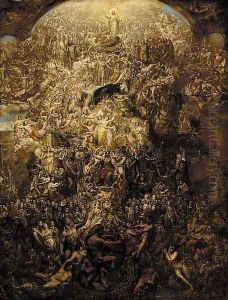James Matthews Leigh Paintings
James Mathews Leigh, born in 1808, was a multifaceted figure in the 19th-century British art scene, known not only for his contributions as an artist but also as an art educator and the founder of Leigh's Academy, a noteworthy establishment in the education of many prominent artists of the time. His life and career were deeply intertwined with the development of art education and the nurturing of artistic talent during a period of significant cultural and social transformation in Britain.
Leigh's early life is somewhat obscure, but it is known that his passion for art was evident from a young age. He pursued his artistic education with dedication, although specific details about his training are sparse. His commitment to art led him to establish Leigh's Academy in London, which became an influential institution. The academy was not merely a school but a hub for innovation and creativity, attracting a wide array of students who would later become significant figures in the British art world. Leigh's teaching philosophy emphasized the importance of drawing from life, a practice that he believed was foundational for any artist. This approach was somewhat revolutionary at the time and contributed to the academy's reputation as a progressive institution.
Leigh's own artistic output, though overshadowed by his role as an educator, was notable for its adherence to classical principles, particularly in his drawings and paintings. His works, characterized by their detailed realism and often historical or literary themes, reflect the academic art standards of the era. However, it is Leigh's contribution to art education and his investment in the future generation of artists that form his most enduring legacy. Through Leigh's Academy, he provided a platform for young artists to develop their skills, experiment with new ideas, and gain exposure to the broader art community.
James Mathews Leigh passed away in 1860, but his impact on the British art scene endured well beyond his lifetime. The alumni of Leigh's Academy would go on to shape the trajectory of British art, contributing to movements and developments that defined the visual culture of the 19th and early 20th centuries. Leigh's vision for art education, emphasizing the importance of direct observation and life drawing, continued to influence teaching philosophies in art schools across Britain. In reflecting on Leigh's contributions, it is clear that his legacy is not solely in the artworks he produced but significantly in the generations of artists he mentored, whose achievements continue to resonate in the history of British art.
